
(1950-present)
"During a visit in New York in the early 1950s I summoned my courage and went to King Features, the great syndicate, and asked if I could buy the comic magazine rights for a character called Dragos that I had seen in the newspaper Svenska Dagbladet. After pointing out my favourite character from a never-ending list of comic characters that King Features owned the rights for, I was told the character's name was The Phantom in English, and that it should be his name all over the world. I was also informed that the syndicate's Scandinavian agent was Bull's Press Service and that they had the rights for the Scandinavian market. When I returned home, I went to "uncle" (Bjarne) Steinsvik, owner and manager of Bull's. I was very young at the time and thought that Steinsvik was an old man, although he was probably not even 60 years old. When I asked for the comic magazine rights, it turned out that "uncle" didn't know such rights existed. Comic characters had until then only been featured as daily strips in the newspapers and Christmas albums. Before the comic magazine Fantomen there had been only one real comic magazine in Sweden, namely Kalle Anka (Donald Duck started in 1948), published by Gutenberghus of Denmark (later Egmont), and that had been licensed straight from Walt Disney. Very Well, "comic magazine rights" were swiftly created and with a contract in my hand I walked out from Bull's. But all difficulties were not overcome yet. My father Tor (Bonnier) was chairman of the board for Åhlén & Åkerlund Publishing and when I suggested the publishing of a comic magazine called the Phantom, my father rose from his chair, slowly walked around the long table of board members, put his hand on my shoulder and said: "Dear son, the Bonnier family has given the Swedish people a Strindberg, a Lagerlöf, a Heidenstam* - and you want to give them The Phantom..." Still, after some of the younger board members had given their approval, my father softened and gave his permission. Later that year, the first issue of Fantomen was released, but that is another story."*August Strindberg, Selma Lagerlöf and Verner von Heidenstam are three of Sweden's most famous writers of all time.
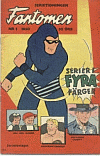 The first issue of Fantomen, with a release date of 5th October 1950 proudly exclaimed "Comics in four colours" on the cover, and was an instant hit. During its first year, with 7 issues published, the magazine sold about 72,000 copies each. The 36 pages in the first issue were shared between The Phantom, Louie (by Harry Hanan), Nancy (by Ernie Bushmiller), Curly Kayoe (by Sam Leff) and Hopalong Cassidy. For the first eight years of Fantomen, daily strip stories were published in strict chronological order, serialised across several consecutive issues. It may seem odd that a magazine entitled Fantomen only had 12 pages of the Phantom, but it was mainly for two reasons. Firstly, Fantomen was based on the European tradition of comic magazines (such as Spirou, Pilote and Asterix from France) which feature a multitude of comic characters. The second reason, believe it or not, was due to the Swedish Post Office! Comic magazines were of course distributed via mail to subscribers, but according to Post Office regulations one "article" (in this case a comic story) was not allowed to take up more than half of the interior pages. This effectively limited Phantom stories to a maximum of 12 pages, and the Phantom stories had to be published in serialised form. These Post Office regulations were in effect up until the 1980s, which is why half of the magazine has always contained other comics. For a brief period in 1959-1960 the magazine was even called Fantomen med Hopalong Cassidy (The Phantom with Hopalong Cassidy). Today it would be almost impossible to change the magazine into an "all-Phantom" magazine, since the readers have come to expect a variety of the world's best comics in the magazine. Because of this, The Phantom himself was a rare guest on the cover for the first decade. Characters from the other comics in the magazine and famous sports stars of the time were more often on the cover.
The first issue of Fantomen, with a release date of 5th October 1950 proudly exclaimed "Comics in four colours" on the cover, and was an instant hit. During its first year, with 7 issues published, the magazine sold about 72,000 copies each. The 36 pages in the first issue were shared between The Phantom, Louie (by Harry Hanan), Nancy (by Ernie Bushmiller), Curly Kayoe (by Sam Leff) and Hopalong Cassidy. For the first eight years of Fantomen, daily strip stories were published in strict chronological order, serialised across several consecutive issues. It may seem odd that a magazine entitled Fantomen only had 12 pages of the Phantom, but it was mainly for two reasons. Firstly, Fantomen was based on the European tradition of comic magazines (such as Spirou, Pilote and Asterix from France) which feature a multitude of comic characters. The second reason, believe it or not, was due to the Swedish Post Office! Comic magazines were of course distributed via mail to subscribers, but according to Post Office regulations one "article" (in this case a comic story) was not allowed to take up more than half of the interior pages. This effectively limited Phantom stories to a maximum of 12 pages, and the Phantom stories had to be published in serialised form. These Post Office regulations were in effect up until the 1980s, which is why half of the magazine has always contained other comics. For a brief period in 1959-1960 the magazine was even called Fantomen med Hopalong Cassidy (The Phantom with Hopalong Cassidy). Today it would be almost impossible to change the magazine into an "all-Phantom" magazine, since the readers have come to expect a variety of the world's best comics in the magazine. Because of this, The Phantom himself was a rare guest on the cover for the first decade. Characters from the other comics in the magazine and famous sports stars of the time were more often on the cover.Fantomen started out as a fortnightly magazine in full colour, until Nr.22/1955 when the colour was dropped. This was an attempt to cut costs, since the sales for Fantomen (and comics in general) were declining by the mid 1950s due to the impact of television. In 1958, the consecutive publishing of daily strips had almost caught up with the new stories in the newspapers, so the publishers swapped over to the Sunday strip, with stories still serialised across several issues, but not in such strict chronological order. The same year, the publishers decided to publish Fantomen weekly and 38 issues were published in 1958, the last issue being a double-issue billed Nr.38-39/1958. This move proved to be nearly fatal for sales, and Fantomen was swiftly back on a fortnightly schedule by the following year. 1959 was also the year when complete stories finally appeared in every issue, although generally they were reprints of stories already run in serialized form. The profile for the whole magazine changed, as the Phantom now began to appear on almost every cover and now clearly was the star of the magazine that carried his name. The magazine also increased in size, from 36 to 68 pages for a standard issue. Sales were still a bit unstable, and with one complete story in each issue, the magazine needed more material than was available. Therefore, the magazine dropped to a monthly publishing schedule in 1960, still with 68 pages per issue.
 Reprinting more and more previously published stories (sometimes for the third time), and only the occasional new daily story, didn't do much to improve sales. To save the situation, the publishers (led by Ebbe Zetterstad) bought the rights to produce their own Phantom stories for the Swedish market. The historic first Swedish Phantom story, drawn by Bertil Wilhelmsson, appeared in Fantomen Nr.8/1963. "Team Fantomen" was born, although at this point it wasn't much of a team ... only one person! This was nearly a year before the first story by Sy Barry appeared in the magazine. Wilhelmsson's stories served as a buffer, since they were a bit more modern than McCoy's style, and so the publishers reasoned the readers wouldn't be too shocked when Barry's stories first appeared in 1964. Wilhelmsson wrote some of his own stories, but some were written by Zetterstad, although which ones exactly are unknown at this time. Only 19 stories were created in this way between 1963 and 1967 (mostly in 1964-65), and the publishers still relied heavily on reprints. Besides being the driving force behind the Swedish Phantom production, Ebbe Zetterstad was also (most likely anyway) the one responsible for the design of the Fantomen logotype for the magazine. Calling the logo unique is an understatement, and it has become a cult symbol for the magazine and the Phantom in Sweden.
Reprinting more and more previously published stories (sometimes for the third time), and only the occasional new daily story, didn't do much to improve sales. To save the situation, the publishers (led by Ebbe Zetterstad) bought the rights to produce their own Phantom stories for the Swedish market. The historic first Swedish Phantom story, drawn by Bertil Wilhelmsson, appeared in Fantomen Nr.8/1963. "Team Fantomen" was born, although at this point it wasn't much of a team ... only one person! This was nearly a year before the first story by Sy Barry appeared in the magazine. Wilhelmsson's stories served as a buffer, since they were a bit more modern than McCoy's style, and so the publishers reasoned the readers wouldn't be too shocked when Barry's stories first appeared in 1964. Wilhelmsson wrote some of his own stories, but some were written by Zetterstad, although which ones exactly are unknown at this time. Only 19 stories were created in this way between 1963 and 1967 (mostly in 1964-65), and the publishers still relied heavily on reprints. Besides being the driving force behind the Swedish Phantom production, Ebbe Zetterstad was also (most likely anyway) the one responsible for the design of the Fantomen logotype for the magazine. Calling the logo unique is an understatement, and it has become a cult symbol for the magazine and the Phantom in Sweden.
 In 1964, the comic publishing department of Bonnier Press adopted the name SEMIC, which is a combination of the word COMIC and its Swedish equivalent SERIER. From 1964 onwards, the number of Fantomen issues increased every year until it was finally back on a fortnightly schedule in 1968. This of course required even more Phantom stories, so rather than create new stories from scratch, the publishers hit on the idea of importing Phantom stories from the American Adventures comics created by Fratelli Spada in Italy (and reprinted in France). These stories had to be edited to fit Fantomen's format (the Italian Phantom comic had a smaller page size) and were often partially redrawn, both to lengthen the stories and to improve the often weak story-lines. The aforementioned Bertil Wilhelmsson, Anders Thorell and Turkish-born artist Özcan Eralp were the artists responsible for "improving" the Italian stories. The first Italian Phantom adventure (actually two stories edited into one) was published in Nr.2/1968, drawn by Germano Ferri (who would much later work for Team Fantomen), with additional art by Özcan Eralp. A total of 79 Italian stories were published in Fantomen from 1968 to 1974. With such a plethora of new material to publish, Semic ceased reprinting old daily and Sunday stories, but still published the new daily and Sunday stories as they finished in the newspapers.
In 1964, the comic publishing department of Bonnier Press adopted the name SEMIC, which is a combination of the word COMIC and its Swedish equivalent SERIER. From 1964 onwards, the number of Fantomen issues increased every year until it was finally back on a fortnightly schedule in 1968. This of course required even more Phantom stories, so rather than create new stories from scratch, the publishers hit on the idea of importing Phantom stories from the American Adventures comics created by Fratelli Spada in Italy (and reprinted in France). These stories had to be edited to fit Fantomen's format (the Italian Phantom comic had a smaller page size) and were often partially redrawn, both to lengthen the stories and to improve the often weak story-lines. The aforementioned Bertil Wilhelmsson, Anders Thorell and Turkish-born artist Özcan Eralp were the artists responsible for "improving" the Italian stories. The first Italian Phantom adventure (actually two stories edited into one) was published in Nr.2/1968, drawn by Germano Ferri (who would much later work for Team Fantomen), with additional art by Özcan Eralp. A total of 79 Italian stories were published in Fantomen from 1968 to 1974. With such a plethora of new material to publish, Semic ceased reprinting old daily and Sunday stories, but still published the new daily and Sunday stories as they finished in the newspapers.
In the meantime, Team Fantomen had expanded. Rolf Gohs, Fantomen's legendary cover artist who started around 1957 and continues to work on the magazine today (!) made his only two Phantom stories in 1966 and 1970. The latter was written by Janne Lundström, who along with Magnus Knutsson were the first two writers in the team. Özcan Eralp created his first "own" Phantom story in 1970, and along with Wilhelmsson was responsible for several re-makes of old Falk/Moore/McCoy stories that were now given a more modern touch. Unlike the re-makes made in recent years (mainly by Felmang), these were much less faithful to the original and often changed a lot of details so it would seem like a brand new story.
Led by the new editor Ulf Granberg (became editor in 1973), the team focused more on producing completely new stories. The addition of Spanish-born artist Jaime Vallvé (who lived in Denmark) marks the point were the Swedish production of Phantom stories really took off. Vallvé's first story appeared in Nr.1/1972 and his style became the guideline for future artists who joined Team Fantomen.
Team Fantomen (with Lundström, Knutsson and Granberg as main writers, and Wilhelmsson, Eralp and Vallvé as main artists) worked hard the following years to satisfy the demand for new stories. It was soon evident that new blood was necessary if these people wouldn't work themselves to an early grave (Vallvé drew up to 8 stories a year!). British writers Norman Worker and Donne Avenell filled the gap as Knutsson and Lundström left Fantomen at the end of the 1970s, and new artists Heiner Bade, Georges Bess and Kari Leppänen joined the art team by 1980. Wilhelmsson and Eralp had worked mainly as a pencil/ink team for a few years, until Wilhelmsson temporarily left in 1979, leaving Eralp on his own again.
The 1970s mark the high-point in Fantomen's success. The average sales were over 160,000 copies per issue and the two best selling issues in the history of the magazine sold well over 200,000 copies each. These issues were not surprisingly Nr.6/1978 (the wedding) and Nr.20/1979 (the birth of the twins).
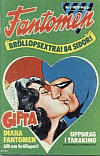

By the mid 1980s, the work of putting together the magazine and overseeing the production of new Phantom comics was too much for one man too handle. Ulf Granberg left his editorial position to become editor-in-chief/publisher in charge of Team Fantomen's efforts. New editor for the magazine was Mats Jönsson, who officially took over the editing duties with the first issue in 1987. After his three-year stint as editor, Jönsson would return as a writer in Team Fantomen in the late 1990s.
Towards the end of the 1980s, the "Latin wave" of artists entered Team Fantomen: César Spadari (Argentina), Carlos Cruz (Argentina/Spain), José Casanovas (Spain) and of course Felmang (Italy), who 20 years earlier had worked on the Phantom for Fratelli Spada in Italy. Among Felmang's many assistants was Germano Ferri, whose art had graced the pages of Fantomen in the late 1960s and early 1970s when Fantomen published material from Fratelli Spada.
Sales had slowly begun to drop by the end of the 1980s, and the publishers decided to start printing the magazine in colour again, starting with Nr.1/1991 (the 40th anniversary issue, Nr.20/1990, had already been in colour as a "test", and included a replica of the first issue from 1950). Unfortunately, many older readers who were used to black & white printing left the magazine, while younger kids found it more interesting. The decision to print in colour didn't do much to stop the decline in sales, but it lowered the average age of the readers. The move to colour arrived just in time for the 1000th edition of Fantomen which was published in August 1991 (Nr.17/1991), only 7 months after Frew Publications had passed the same milestone in Australia.
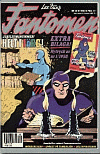
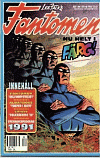

Another attempt to increase sales was the (in)famous Lubanga story-line that began in 1994. It all began in December 1992 when Ulf Granberg summoned a group of people to the first (of many) Phantom seminars. Present were (besides Granberg) Björn Ihrstedt (editor of Fantomen), Finn-Jørgen Solberg (editor of Norway's Fantomet), Anders Thorell (from the marketing department), Hans Lindahl (writer/artist), Lennart Moberg (writer/artist) and Claes Reimerthi (writer). The purpose of the seminar was to re-evaluate the Phantom concept and suggest any possible changes. One idea from Reimerthi was to create a foe that would seriously threaten the Phantom and not so easily be defeated. The Phantom would also be deprived of many things that had helped him in the past; he would no longer have control over the Jungle Patrol, Luaga would no longer be president, and Diana and the twins would move to the USA. The storyline demanded a completely new approach both from editors and Team Fantomen. Instead of every writer coming up with their stories on their own (as was the case before), they had to follow the guidelines set up on the seminars (nick-named "The Brain Trust") to make each story fit into the Lubanga storyline. Creatively, this was a highpoint for team Fantomen, with exciting and refreshing stories. However, despite a massive award-winning ad campaign it didn't affect the sales much at all. Therefore, in 1996 Lubanga was kicked out and the stories became more of the stand-alone sort again. "The Brain Trust" still meets once or twice a year to set up the guidelines for the comic's future direction. Granberg, Moberg, Lindahl, Reimerthi and Ihrstedt (until he left as editor in 2001) have always been the "core" of the Brain Trust, with other creators coming in from time to time.
In an attempt to lower production costs, Fantomen and the Finnish Musta Naamio magazine were co-published from 1994 onwards. At the same time the standard issue was also increased in size from 68 to 84 pages, which would last until 1997 when it was back to 68 pages again. Co-printing means that both editions are printed at the same time and contents are therefore identical, with the exception of the different languages and the covers (printed separately). Norway's Fantomet joined the co-production in 1996. Musta Naamio was temporarily a monthly magazine from 1997 to 2000, basically meaning that they skipped half of the Fantomen issues. Musta Naamio is now back on 26 issues a year, albeit without the 8-page lift-out fanclub section that now appears in Fantomen and Fantomet and gives those two magazines a bit more national identity.
To celebrate the 60th anniversary of The Phantom in 1996, the first five Falk-Moore Sunday stories from 1939-41 were reprinted in Fantomen. A separate comic called Fantomen - Den Vandrande Vålnaden (The Phantom - The Ghost Who Walks) was launched the same year, and it contained chronological reprints of Falk-Barry daily stories starting with The Slave Market of Mucar (D82). The series of Falk-Barry daily reprints was moved to Fantomen in 1997, and a new series of chronological Falk-Barry Sunday strips was added in 1999. Both of these chronological series of strips continue to appear in Fantomen today. Classic Lee Falk stories are firmly back on the agenda in Fantomen magazine!
In 1997, the Bonnier family sold off SEMIC to the Danish company Egmont, until then best known for their involvement in publishing and producing Disney comics. The staff remained the same on all former SEMIC magazines though, so the change of ownership didn't cause any immediate changes for the magazine. Only months later, Egmont bought the only remaining competitor in the Swedish comic magazine publishing industry; Atlantic. For a brief period, Egmont had a complete monopoly on the Swedish comic magazine market, which luckily is not the case today.
Egmont immediately conducted a very extensive market research for the Fantomen magazine, and came to some interesting conclusions. For example, it had been generally believed that the majority of the readers were in the early teens, but the research showed that it was younger than that, from age 8 to 12. A clear example of the change in focus for the magazine is that occasionally gadgets such as Phantom rings, mouse-pads, playing cards etc are sometimes packaged with the magazine. Such things appeal to the younger readers, and can boost sales with up to 20,000 extra copies. Today, the sales for the magazine have stabilized around 35,000-40,000 copies per issue. A very respectable figure for comics in Sweden these days.
After the "Latin wave" in Team Fantomen came the "American wave". Despite being an American creation to begin with, no Americans had been involved in Team Fantomen until 1991. First was none other than George Olesen, longtime assistant to Sy Barry on the newspaper strips. Olesen drew two stories in 1991, which are the only two Phantom stories he has done complete artwork for (ie. including the inking). Writer Tony De Paul entered in 1993, followed by Ben Raab (writer, 1999), Paul Ryan (artist, 2001), Don Perlin (artist, 2001), Dick Giordano (artist, 2002), and Graham Nolan (writer, 2003). With the exception of Perlin, these newcomers have been well-received by the readers, and it seems the feeling is mutual. For veterans (almost legends!) like Ryan and Giordano, the Phantom is not only refreshing but also a classic adventure strip, which is hard to find in the states these days.
Following the death of Lee Falk in 1999, Egmont stepped into the breach and provided some Phantom stories to fill the gap in the daily and Sunday strips. An agreement was entered into where Egmont would continue to provide new stories, with Tony De Paul writing for the dailies and Claes Reimerthi for the Sundays. In 2003, Reimerthi withdrew from the Sundays and now both strips are written by Tony De Paul.
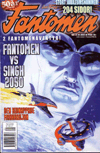
| Rolf Jansson | 1950-1951 |
| Calle Wästfeldt | 1952-1953 |
| Rolf Lindberg | 1954-1956 |
| Bengt Cramner | 1957 |
| Ebbe Zetterstad | 1958-1961 |
| Jan E. Israelsson | 1962 |
| Per-Erik Gustavsson | 1963-1968 |
| J. O. Olsson | 1968 |
| Per-Henrik Cellton | 1968-1969 |
| Lennart Hartler | 1969-1972 |
| Per-Anders Jonsson | 1972-1973 |
| Ulf Granberg | 1973-1986 |
| Mats Jönsson | 1987-1990 |
| Björn Ihrstedt | 1990-2001 |
| Michael Jaatinen | 2001-2003 |
| Petter Sjölund | 2003- |
 © 2003 KING FEATURES SYNDICATE, INC. THE HEARST CORPORATION
© 2003 KING FEATURES SYNDICATE, INC. THE HEARST CORPORATION